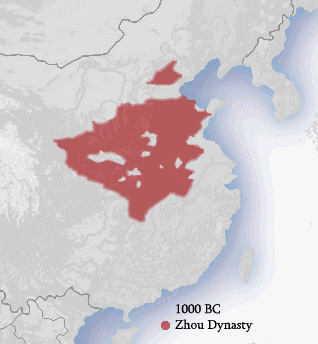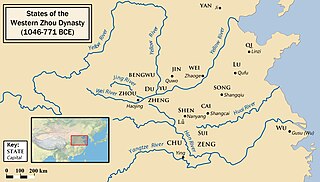Related Research Articles

The Zhou dynasty was a royal dynasty of China that existed for 789 years from c. 1046 BC until 256 BC, the longest such reign in Chinese history. During the Western Zhou period, the royal house, surnamed Ji, had military control over ancient China. Even as Zhou suzerainty became increasingly ceremonial over the following Eastern Zhou period (771–256 BC), the political system created by the Zhou royal house survived in some form for several additional centuries. A date of 1046 BC for the Zhou's establishment is supported by the Xia–Shang–Zhou Chronology Project and David Pankenier, but David Nivison and Edward L. Shaughnessy date the establishment to 1045 BC.

The Shang dynasty, also known as the Yin dynasty, was a Chinese royal dynasty that ruled in the Yellow River valley during the second millennium BC, traditionally succeeding the Xia dynasty and followed by the Western Zhou dynasty. The classic account of the Shang comes from texts such as the Book of Documents, Bamboo Annals and Records of the Grand Historian. Modern scholarship dates the dynasty between the 16th to 11th centuries BC, with more agreement surrounding the end date than beginning date.

The Spring and Autumn period in Chinese history lasted approximately from 770 to 481 BCE which corresponds roughly to the first half of the Eastern Zhou period. The period's name derives from the Spring and Autumn Annals, a chronicle of the state of Lu between 722 and 481 BCE, which tradition associates with Confucius. During this period, royal control over the various local polities eroded as regional lords increasingly exercised political autonomy, negotiating their own alliances, waging wars amongst themselves, up to defying the king's court in Luoyi. The gradual Partition of Jin, one of the most powerful states, is generally considered to mark the end of the Spring and Autumn period and the beginning of the Warring States period.

The Western Zhou was a period of Chinese history, approximately first half of the Zhou dynasty, before the period of the Eastern Zhou. It began when King Wu of Zhou overthrew the Shang dynasty at the Battle of Muye and ended when Quanrong pastoralists sacked its capital Haojing and killed King You of Zhou in 771 BC.
Duke Wen of Eastern Zhou, personal name Jī Jié, reigned as King Hui of Zhou over the remaining rump state of the Zhou dynasty from 255 BC to 249 BC, when he was captured and executed by the army of Qin. Wen was the last member of the Zhou dynasty who claimed the throne of China, though he was never recognized as king outside his own small domain at Chengzhou. Forced to spend his entire reign fighting against the state of Qin, Wen's death meant the final end of the Zhou dynasty.

Jin, originally known as Tang (唐), was a major state during the middle part of the Zhou dynasty, based near the centre of what was then China, on the lands attributed to the legendary Xia dynasty: the southern part of modern Shanxi. Although it grew in power during the Spring and Autumn period, its aristocratic structure saw it break apart when the duke lost power to his nobles. In 403 BC, the Zhou court recognized Jin's three successor states: Han, Zhao, and Wei. The Partition of Jin marks the end of the Spring and Autumn period and the beginning of the Warring States period.

Dan, Duke Wen of Zhou, commonly known as the Duke of Zhou, was a member of the royal family of the early Zhou dynasty who played a major role in consolidating the kingdom established by his elder brother King Wu. He was renowned for acting as a capable and loyal regent for his young nephew King Cheng, and for successfully suppressing the Rebellion of the Three Guards and establishing firm rule of the Zhou dynasty over eastern China. He is also a Chinese culture hero credited with writing the I Ching and the Book of Poetry, and establishing the Rites of Zhou.

Duke Huan of Qi, personal name Xiǎobái (小白), was the ruler of the State of Qi from 685 to 643 BC. Living during the chaotic Spring and Autumn period, as the Zhou dynasty's former vassal states fought each other for supremacy, Duke Huan and his long-time advisor Guan Zhong managed to transform Qi into China's most powerful polity. Duke Huan was eventually recognized by most of the Zhou states as well as the Zhou royal family as Hegemon of China. In this position, he fought off invasions of China by non-Zhou peoples and attempted to restore order throughout the lands. Toward the end of his more than forty-year-long reign, however, Duke Huan's power began to decline as he grew ill and Qi came to be embroiled in factional strife. Following his death in 643 BC, Qi completely lost its predominance.

King Zhuang of Chu was a monarch of the Zhou dynasty State of Chu during the Spring and Autumn period in ancient China. His personal name was Xiong Lü, his ancestral name was Mi, and his posthumous title was King Zhuang. He was one of the five rulers dubbed the Five Hegemons by Xunzi and attempted to wrest control of China from King Ding of Zhou.

Lu was a vassal state during the Zhou dynasty of ancient China located around modern Shandong. Founded in the 11th century BC, its rulers were from a cadet branch of the House of Ji (姬) that ruled the Zhou dynasty. The first duke was Boqin, a son of the Duke of Zhou, who was brother of King Wu of Zhou and regent to King Cheng of Zhou.
Zou, originally Zhu or Zhulou, was a minor state that existed during the Zhou dynasty of ancient China.

Lü is the pinyin and Wade–Giles romanisation of a Chinese surname, most commonly 吕 and 呂.
Duke Wu of Jin, ancestral name Ji (姬), given name Cheng (稱) and also known as Duke Wu of Quwo, was the eighteenth ruler of the state of Jin. He was also the last ruler of the state of Quwo before he gained the title as the duke of Jin.

The State of Xu was an independent Huaiyi state of the Chinese Bronze Age that was ruled by the Ying family (嬴) and controlled much of the Huai River valley for at least two centuries. It was centered in northern Jiangsu and Anhui.

The Rebellion of the Three Guards, or less commonly the Wu Geng Rebellion, was a civil war, instigated by an alliance of discontent Zhou princes, Shang loyalists, vassal states and other non-Zhou peoples against the Western Zhou government under the Duke of Zhou's regency in late 11th century BC.
Duke Xian I of Qin was from 715 to 704 BC the eighth ruler of the Zhou dynasty Chinese state of Qin that eventually united China to become the Qin dynasty. His ancestral name was Ying, Personal Name is Li,and Duke Xian was his posthumous title. His title was recorded as Duke Ning of Qin (秦寧公) in the Records of the Grand Historian by Han dynasty historian Sima Qian, but inscriptions on excavated bronzes from the era have proven that "Ning" (寧) was a miscopy of the correct character "Xian" (憲).
Duke Zhuang I of Qi was from 794 to 731 BC the twelfth recorded ruler of the State of Qi during the Zhou dynasty of ancient China. His personal name was Lü Gou (呂購), ancestral name Jiang, and Duke Zhuang was his posthumous title. He was the first of the two Qi rulers called Duke Zhuang.

Duke Huan of Lu was from 711 to 694 BC the 15th ruler of the State of Lu during the Spring and Autumn period of ancient China. His ancestral name was Ji, given name Yun (允) or Gui (軌), and Duke Huan was his posthumous title.

The Eastern Zhou is a period in Chinese history comprising the latter half of the Zhou dynasty from c. 771 BCE to 256 BCE, following the Zhou capital's relocation eastward to Chengzhou, near present-day Luoyang. The Eastern Zhou was characterised by the weakened authority of the Zhou royal house, it is subdivided into two parts: the Spring and Autumn period, during which the ancient aristocracy still held power in a large number of separate polities, and the Warring States period, which saw the consolidation of territory and escalation of interstate warfare and administrative sophistication.

Zhongli was an ancient Chinese state in the Huai River valley during the Spring and Autumn period. Its core area was located in the modern-day Fengyang County. At its peak, Zhongli was powerful enough to fight off various other states, and served as an important cultural, political, and economic centre. The state was conquered by its expansionist neighbor Chu during the 6th century BC, but its former capital city remained regionally important for several subsequent centuries.
References
- ↑ Nivison, David S. (1999). The Key to the Chronology of the Three Dynasties: The "Modern Text" Bamboo Annals. Dept. of Asian and Middle Eastern Studies, University of Pennsylvania. p. 25.
- ↑ Lei, Haizhong (2020). Chinese Culture and the Chinese Military. Cambridge University Press. p. 174. ISBN 978-1-108-47918-9.
- ↑ Shaughnessy, Edward L. (1991). Sources of Western Zhou History: Inscribed Bronze Vessels. University of California Press. p. 221. ISBN 0-520-07028-3.